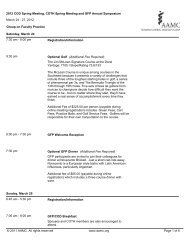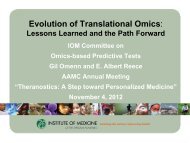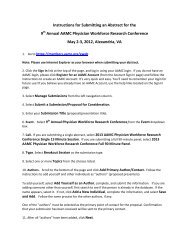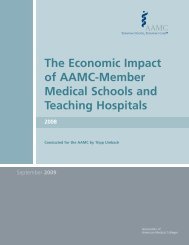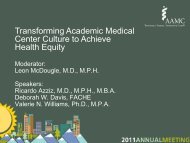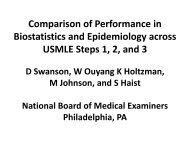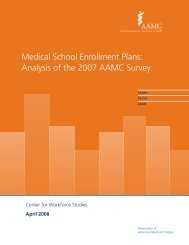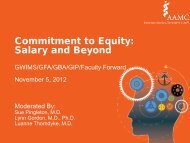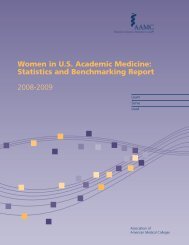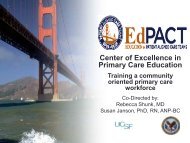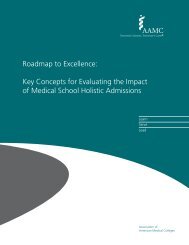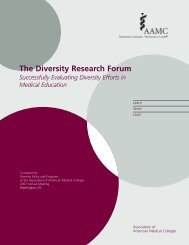A Readiness for Clerkship Survey: Can Self- Assessment Data be ...
A Readiness for Clerkship Survey: Can Self- Assessment Data be ...
A Readiness for Clerkship Survey: Can Self- Assessment Data be ...
Create successful ePaper yourself
Turn your PDF publications into a flip-book with our unique Google optimized e-Paper software.
A <strong>Readiness</strong> <strong>for</strong> <strong>Clerkship</strong> <strong>Survey</strong>: <strong>Can</strong> <strong>Self</strong>-<br />
<strong>Assessment</strong> <strong>Data</strong> <strong>be</strong> Used to Evaluate<br />
Program Effectiveness
Authors<br />
EVALUATION STUDIES UNIT
What’s new<br />
EVALUATION STUDIES UNIT
<strong>Self</strong>-<strong>Assessment</strong>-Accuracy<br />
Invalid Predictor of Individual Per<strong>for</strong>mance<br />
• Woolliscroft et al. Acad Med 68(4):285-294,1993<br />
• Ward, Gruppen and Regehr. Adv Health Sci Educ<br />
Theory Pract. 7:63-80, 2002<br />
• Weiss et al. Med Teach 27(5):445-449,2005<br />
• Davis et al. JAMA 296:1094-1102, 2006<br />
EVALUATION STUDIES UNIT
<strong>Self</strong>-<strong>Assessment</strong> <strong>Data</strong><br />
“Wisdom of Crowds” Surowiecki 2004<br />
<strong>Can</strong> accurate in<strong>for</strong>mation <strong>be</strong> gained by<br />
aggregating many flawed opinions<br />
EVALUATION STUDIES UNIT
<strong>Self</strong>-<strong>Assessment</strong> <strong>Data</strong><br />
“Wisdom of Crowds” Surowiecki 2004<br />
<strong>Can</strong> accurate in<strong>for</strong>mation <strong>be</strong> gained by<br />
aggregating many flawed medical student<br />
opinions<br />
EVALUATION STUDIES UNIT
Gaps in Program Evaluation…<br />
• Generally limited to:<br />
• student opinion of the quality of individual courses,<br />
clerkships, longitudinal courses and curricular<br />
components<br />
• student per<strong>for</strong>mance data and other student-related<br />
outcome data<br />
• “The whole is greater than the sum of its parts”<br />
• No instruments to evaluate the function of the preclerkship<br />
curriculum as a whole in preparing students<br />
<strong>for</strong> clerkship<br />
• Faculty input is seldom collected<br />
EVALUATION STUDIES UNIT
The Call <strong>for</strong> Competency-Based<br />
Education<br />
• Harden 2002, Developments in outcome-based<br />
education. Med Teacher 24(2): 117-120.<br />
• <strong>Can</strong>Meds 2005<br />
• AFMC Future of Medical Education in <strong>Can</strong>ada 2010<br />
• “Educating Physicians: a call <strong>for</strong> re<strong>for</strong>m of medical<br />
school and residency 2010”<br />
EVALUATION STUDIES UNIT
<strong>Readiness</strong> <strong>for</strong> <strong>Clerkship</strong> <strong>Survey</strong><br />
Competency-based<br />
Represents the competencies that the program<br />
should enable students to achieve<br />
Instrument was blueprinted/developed using<br />
several documents which adequately capture<br />
educational goals of the preclerkship program<br />
• UBC MD Program Graduate Competencies<br />
EVALUATION STUDIES UNIT
Competency-based<br />
<strong>Readiness</strong> <strong>for</strong> <strong>Clerkship</strong> <strong>Survey</strong><br />
List of action statements that articulate<br />
competencies in:<br />
• cognitive skills<br />
• clinical skills<br />
• professional <strong>be</strong>haviours<br />
Mapped back to the source documents<br />
Addressed gaps and redundancies<br />
Expert review<br />
EVALUATION STUDIES UNIT
<strong>Readiness</strong> <strong>for</strong> <strong>Clerkship</strong> <strong>Survey</strong><br />
• Student version – self-assessment<br />
• Please rate your ability, i.e., competence to do<br />
or per<strong>for</strong>m the activities listed <strong>be</strong>low...<br />
• Faculty version – observe/assessor<br />
• Please rate the level of competency, as a group,<br />
of NEW third year UBC medical students at the<br />
<strong>be</strong>ginning of the rotation to do or per<strong>for</strong>m the<br />
activities listed <strong>be</strong>low...<br />
• 39 items in order of a typical patient<br />
encounter<br />
EVALUATION STUDIES UNIT
<strong>Survey</strong> AFTER starting clerkship<br />
Sent 3-5 months after the start of Year 3<br />
• Third year students<br />
• 2011 (n = 179; 68%)<br />
• 2012 (n = 171; 64%)<br />
• Faculty<br />
• 2011 (n = 384; 26%)<br />
• 2012 (n = 419; 39%)<br />
EVALUATION STUDIES UNIT
How should we analyze the data<br />
Discriminate <strong>be</strong>tween raters<br />
Discriminate <strong>be</strong>tween the items<br />
EVALUATION STUDIES UNIT
Generalizability studies<br />
Students<br />
Faculty<br />
2011 2012 2011 2012<br />
Item 16.10 31.82 7.90 13.31<br />
Rater 28.78 27.22 48.56 39.90<br />
Item x Rater 55.12 40.96 43.54 46.80<br />
EVALUATION STUDIES UNIT
Decision studies<br />
Are students able to reliably differentiate <strong>be</strong>tween<br />
aspects of competence they, as a group, possess<br />
Students *<br />
G G(n) k<br />
2011 (n = 137) 0.16 0.96 21<br />
2012 (n = 104) 0.32 0.98 9<br />
Faculty †<br />
2011 (n = 89) 0.08 0.88 45<br />
2012 (n = 104) 0.13 0.94 26<br />
EVALUATION STUDIES UNIT
How accurate are students’<br />
judgments in aggregate<br />
Student vs Faculty 2011 2012<br />
r 0.88 0.91<br />
• Students rated themselves higher<br />
• 38/39 items 2011 and 34/39 items 2012 p
Two Subscales Identified<br />
1. Clinical skills and Knowledge Application<br />
• Obtaining and interpreting in<strong>for</strong>mation from and about the<br />
patient, and integrating this with prior knowledge leading to the<br />
<strong>for</strong>mulation of a diagnosis and management.<br />
2. Working as a professional<br />
• Being responsible <strong>for</strong> and interacting with the patient and team,<br />
and demonstrating self-care and self-directed learning.<br />
Subscale reliability ranged from .90 to .94<br />
EVALUATION STUDIES UNIT
Summary<br />
• Aggregated student self-assessments:<br />
• Reliably differentiate <strong>be</strong>tween different aspects of<br />
competence<br />
• Correlate well with faculty data<br />
• Require fewer students than faculty<br />
• Identify strengths and weaknesses of the<br />
program<br />
• <strong>Survey</strong> items cluster into meaningful constructs<br />
that align with a competency framework<br />
EVALUATION STUDIES UNIT
Limitations<br />
Faculty response rates<br />
Do not reflect the absolute competence of the<br />
group<br />
Are strengths and weaknesses unique to our<br />
program<br />
EVALUATION STUDIES UNIT
Parting Comment<br />
<strong>Readiness</strong> survey can <strong>be</strong> used to evaluate<br />
the function of the pre-clerkship curriculum<br />
• <strong>Survey</strong> should <strong>be</strong> tailored to reflect the<br />
expected competencies<br />
EVALUATION STUDIES UNIT
Thank you<br />
Linda.peterson@ubc.ca<br />
EVALUATION STUDIES UNIT
Rank Order 10 Lowest<br />
EVALUATION STUDIES UNIT
Rank Order 10 Highest<br />
EVALUATION STUDIES UNIT
Internal Consistency of the instrument<br />
Do items cluster into meaningful constructs<br />
that align with a competency framework<br />
Student/faculty and cohort comparisons<br />
Factor analysis: exploratory and confirmatory<br />
EVALUATION STUDIES UNIT



